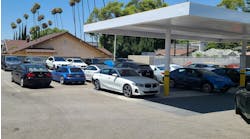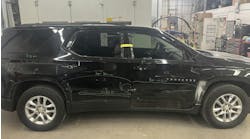Motor Age tested both models, and each performed well. For this month's test, we took the V40 on a combination of highways and back roads, specifically concentrating on things such as merging power (it has it), smoothness of the automatic transmission and the effectiveness of the climate control system.
On the last point, we can honestly say the V40's climate control system is one of the best we have used. The climate control is, we would even say, a "set it and forget it" system - something that most other carmakers are working towards.
The turbocharged, all-aluminum RN generation engine (RN stands for Revised N-Series) has been revised to comply with the latest emissions and fuel economy standards. It incorporates Continuously Variable Valve Timing (CVVT) on the exhaust camshaft. This powerplant makes 160-horsepower (hp) at 5,100 rpm and 177 lbs.-ft. of torque at 1,800 rpm.
A five-speed automatic replaces the former four-speed automatic. According to the automaker, fuel economy is improved, due to the longer ratio of the fifth gear. Smaller steps between gears will achieve slight acceleration, performance and top speed improvements as well. The shorter first gear yields better "take off" performance.
To us, it meant quieter shifting without having the transmission 'hunt' for a gear.
For safety, this wagon rivals other Volvos in offering an inflatable curtain to protect passengers' heads, as well as side-impact beams and side airbags, and variable, or "intelligent," airbags in the front seats.
The rear cargo room design is well thought out, and it provides cargo restraint netting and the now customary retractable luggage cover.
The Volvo performs extremely well with a four-cylinder engine plus turbo, thus offering an alternative to buying a six-cylinder engine-equipped wagon. Gas mileage was consistently in the mid- to high 20s in our actual extended tests, depending on city vs. highway driving. The V40 also performed well in handling and braking tests.
A weather package offering includes heated front seats with high and low settings.
There was little to criticize in the V40 that we could find, with the possible exception of the driver display. It can be hard to read in the daytime for anyone, but particularly for older drivers. However, at night, the dash is a virtual light show and presents no problem to see and decipher.
Overall, we'd give the V40 high marks. And with the sudden new retro craze toward station wagons (although they are coming up with cute euphemisms for them other than that phrase), Volvo probably has a repeat winner here.




